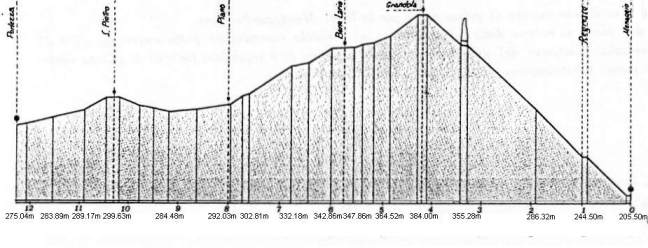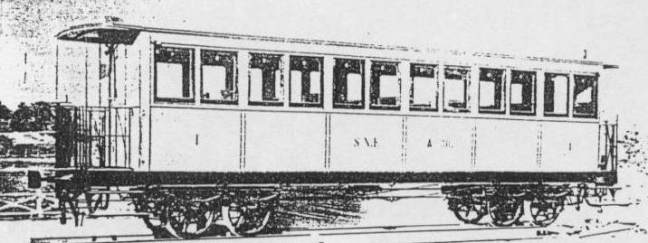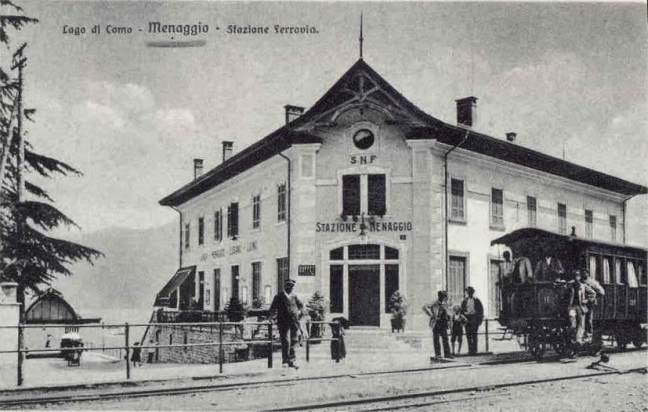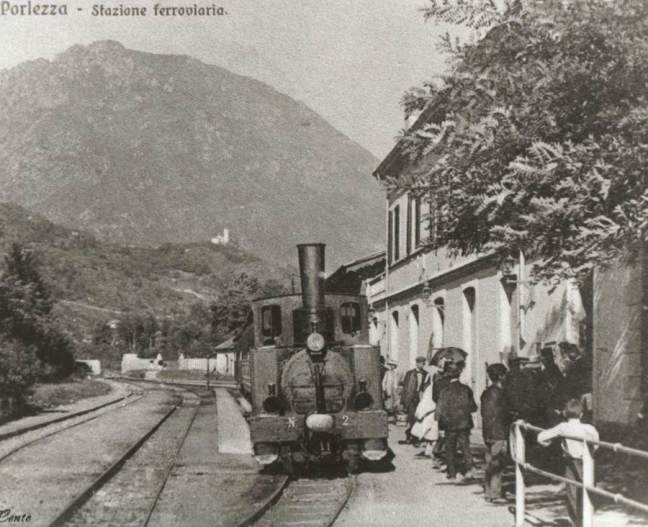© Richard J. Marshall, 2006
Introduction
The large lakes lying in the foothills of the Alps north of Milan and near the border between Italy and Switzerland have been popular tourist destinations for over 100 years. The development of this tourist traffic owes much to a small railway of which little trace now remains. This article briefly describes that railway and its history. A more detailed history (in Italian) was written in 1984 by Bruno Porta.
Looking at a map of northern Italy between Lake Maggiore and Lake Como you can see that both these large lakes lie on a roughly north-south axis about 50 km apart. While the southern foothills of the Alps are not as tall as the mountains to the north, their steep slopes are nevertheless a barrier to overland travel. For centuries the lakes have provided the easiest means of north-south transport, but travelling east-west has been more difficult, requiring either a long detour to the south or a steep climb over the alpine foothills.
In between the two large lakes lies the smaller, hook-shaped Lake Lugano which lies on an east-west axis, with the town of Lugano (in Switzerland) on the northern shore at the lake’s mid-point. At either end of Lake Lugano is about 12 km of land separating it from the two larger lakes. In the 19th century this route provided the most obvious direct link between Lake Maggiore and Lake Como.
At the western end of Lake Lugano, the easiest route was along the Tresa river which connects small town of Ponte Tresa on Lake Lugano with the large industrial town of Luino on Lake Maggiore. At the other end of Lake Lugano, the eastern link from Porlezza was not so easy, requiring a climb over the pass at Cardano (377 metres above sea level) before a sharp 178 metre descent into Menaggio.
Menaggio is situated on the western shore of Lake Como at the mouth of the Senagra river. The Romans conquered the area in 196 BCE and built the historic road called “Via Regina”, connecting the Lombardy plain with the area north of the Alps. The modern day road along the western shore of Lake Como follows the route of the Via Regina. The Via Regina was an important commercial and travel route, and Menaggio became strategically important because of its position on the Via Regina. In the Middle Ages a castle was built and Menaggio was surrounded by walls. The castle was destroyed in 1523 but some of the town walls still remain.
By the middle of the 19th century Menaggio was already a well known resort and a number of large hotels were constructed.
Construction
In 1872 a railway line was proposed linking Menaggio to the town of Lugano and then onto Luino, on the eastern shore of Lake Maggiore. This proposal was soon reduced to construction of two separate lines linking Menaggio and Porlezza at the eastern end of Lake Lugano and Luino and Ponte Tresa at the western end of Lake Lugano. Ponte Tresa – Lugano – Porlezza traffic was to be serviced by steamboats along Lake Lugano. The change of plan was caused partly by difficulties in financing the proposal, particularly the substantial engineering works that would be required between Porlezza and Lugano, and partly over concern about opposition to the proposal from boat operators on the lake. The two railway lines were each just over 12 km in length.
On the 23 August 1873 government authorisation was given to form a company to build and operate the two railway lines. Although the railway lines were to be built on Italian territory, the company was based in Switzerland and finance provided by the Banca per la Svizzera Italiana [Bank for Italian Switzerland]. The Società di Navigazione e Ferrovie pel lago di Lugano (generally known by the acronym SNF) [the Navigation and Railways of Lake Lugano Company] was authorised to build narrow gauge railways between Menaggio and Porlezza and between Ponte Tresa and Luino and to operate them until 6 January 1973. Opposition to the plan delayed construction and it was not until June 1883 that contracts for the supply of materials and construction were awarded.
The track was laid to the unusual gauge of 850mm. The rail weighed 27 kg per metre (~ 60 lb per yard) which had an expected lifespan of 60 to 70 years. The only tunnel on the Menaggio to Porlezza line, just east of Grandola, was 90 metres in length, 3.3 metres wide and had a height of 3.9 metres above track level. Bridges along the Menaggio to Porlezza line included a three arch brick and stone structure across the stream in the Fontanin valley, a stone bridge over the Menaggio to Porlezza road about 4.5 km from Menaggio and two iron bridges, one 24 metres long over the Cussio torrent and the other 10 metres long over the Rezzo torrent.
The intermediate station buildings at Grandola, Bene Lario, Carlazzo, S. Pietro di Sovera and Tavordo were similar in design having between 6 and 8 rooms, which included a ticket office, a baggage room, a small parcels office and lodgings for the stationmaster. The façade to each building had a plaque showing the altitude of the station.
In March 1884 the first of the 6 locomotives ordered by the company arrived at Lugano and was transported by boat to Porlezza. Construction was nearing completion by June, but opening of the line was delayed by the late arrival of the final two locomotives and by an outbreak of cholera which caused the closure of the Italy-Switzerland border for a month. The Menaggio-Porlezza line opened on Wednesday 8 October 1884. The Ponte Tresa-Luino line opened on 26 February 1885.
Construction of the Menaggio – Porlezza line had cost 1.1 million Swiss Francs (1.2 million Italian Lire).
The Route of the Railway
Menaggio railway station was situated at the southern end of the town on the opposite side of the road to the Hotel Menaggio. The hotel sits between the main road (Via Regina) and Lake Como, not far from where the lake ferries call. Because of the large difference in height between Menaggio (199 metres above sea level) and the pass at Cardano (377 metres above sea level) 3 km to the west, the line headed south in direction of Griante for approximately 900 metres rising on a slope of 5% (1 in 20). The track ran along the side of Mount Crocetta, until reaching the valley of the Valstera torrent where it reversed direction. The switchback (“regresso”) was approximately 140 metres in length and built on the level. Here the locomotive was detached from the train, turned on a small turntable and by means of a loop line, run around the train and attached to the other end. This manoeuvre was controlled by waiving red flags, followed by long and short whistles.
The train then continued its climb in a northerly direction. This section contained several engineering works to keep the curves to not less than 50 metres radius. The railway continued to climb on a slope of 5%, tracing an S shape, crossing the Menaggio Porlezza road before turning west in a wide curve into the Senagra valley. Above the line, and on the left hand side of the railway, stood the hamlet of Croce (423 metres above sea level). The climb was briefly broken by 90 metres of level track through a tunnel near Croce. Approximately 800 metres after the tunnel was the station of Grandola and Uniti, 5 km from Menaggio. The station had a passing loop and a short siding. The waiting room stood on the right (Cardano side) of the line.
After Grandola the railway abandoned the Senagra valley and descended westwards through open countryside towards Porlezza. The route of the railway continued parallel to and on the left side of the road with curves not less than 80 metres in radius. Approximately 1800 metres from Grandola was the station Bene Lario and Grona. The line from this point descended towards the lake of Piano and, 9 km from Menaggio, was the station of Piano di Porlezza (298 metres above sea level). The reed covered lake of Piano (278 metres above sea level) is approximately 1300 metres long and 900 metres wide.
Continuing on its journey the train arrived at the station of S. Pietro di Sovero (height 292 metres above sea level), serving Carlazzo and the hamlets and villages of the Cavargna valley to the north. 800 metres beyond the bridge over the Cuccio torrent was the station of Tavordo (283 metres above sea level). Approximately 700 metres from Tavordo the railway crossed the Rezzo torrent, then made a turn to the left in order to avoid the built up area of Porlezza (274 metres above sea level). Porlezza station was built overlooking lake Ceresio (Lake Lugano) and a right angles to the lake.
Unfortunately I have been unable to locate more than brief details about the Ponte Tresa to Luino line. The route followed the Tresa river which drains Lake Lugano into Lake Maggiore at Luino, descending about 70 metres in the process. Consequently the gradients on the line were less steep than on the Menaggio-Porlezza line.
The Locomotives
To service the Menaggio to Porlezza and Ponte Tresa to Luino lines, six steam locomotives were built by Maschinenfabrik di Emil Kessler at Esslingen, Germany. Each locomotive carried the name of a notable person from the Swiss Ticino or Italian Como regions:
- Stefano Franscini (Statesman and writer 1796-1857)
- Giovanni Batiste Pioda (army colonel and politician 1786-1845)
- Vincenzo Vela (sculptor 1820-1891)
- Giocondo Albertolli (architect 1742-1839)
- Bernardino Luini (painter c1480/90-1532)
- Alessandro Volta (physicist 1745-1827)
Four locomotives were 0-6-4T (0.3.2 in European notation) tank engines with two twin outside cylinders. The driving wheels were 1060mm in diameter and the trailing wheels 900mm. The 0-6-4T locomotives were 7.5 metres long, 3.5 metres high, and 1.85 metres wide, and weighed 13 tons. The water tanks ran along each side of the boiler from about 1 metre behind the smoke-box to the cab. The other two locomotives were 0-6-0T (0.3.0) tank engines and in appearance were simply shorter versions of the 0-6-4T locomotives, with a shorter boiler and a smaller cab aligned immediately behind the rear driving wheel. The locomotives had a maximum speed of 45 km/hour.
In 1905 a short and unsuccessful trial of petrol engine light rail-cars was tried on both the Menaggio-Porlezza and Ponte Tresa-Luino lines. The motors of the rail-cars were subsequently removed and the former rail-cars were used as carriages for a while.
The Carriages and Wagons
The carriages were built in workshops at St. Elena in Venice. All were built with 8 wheels mounted on two twin-axle bogies and were fitted with Westinghouse air brakes. Photographs of the railway suggest most of the carriages were entered by means of platforms at either end of the carriage. Some first class carriages were split into two sections, each seating 8 people, divided by a platform in the centre of the carriage in addition to the end platforms. Carriages were painted olive green with the company acronym S.N.F. in the middle of each flank. In addition the company owned a rarely used but elegant carriage named “DE PRETIS” dedicated to the minister who inaugurated the railway.
The stock of goods vehicles comprised of thirteen 4-wheel wagons with a 5 ton capacity and ten 8-wheel bogie wagons with a 10 ton capacity. The 10 ton wagons were built after the line was opened to handle bulky goods such as lumber, barrels and casks.
The Train Service 1885-1918
The 1885 timetable showed two round-trips each day leaving Porlezza at 07:40 and 13:25 and departing on the return trip from Menaggio at 11:00 and 14:50. The timetable allowed 58 minutes to travel in either direction. The slowest section was the 21 minute steep climb or descent between Menaggio and Grandola which included the reversing manoeuvre at the “regresso”.
Subsequent timetables had four, five or six round-trips each day with the journey time reduced to 50 minutes. Normal train services were operated by a single locomotive hauling a maximum load of 49 tons (up to three carriages or 10 ton wagons). Photographs of the railway indicate that locomotives always ran smoke-box first except on the short descent from the regresso into Menaggio where the locomotives ran cab first. Turntables at Menaggio, Porlezza and the regresso enabled the locomotives to be turned.
In 1911 an average of 37 steamboats visited Menaggio each day. A large proportion of the 234,000 passengers embarking or disembarking at Menaggio in 1911 used the Menaggio-Porlezza railway.
The tourist traffic on which the railway depended ended abruptly with the outbreak of the First World War in August 1914. After Italy declared war against Austria in May 1915, the railway was used to transport troops and military material to build and supply impressive defence lines in the surrounding mountains (on Monte Crocetta and Monte Crocione).
The Train Service 1918-1939
In June 1918 the SNF decided to sell the Menaggio-Porlezza and Ponte Tresa-Luino railways and concentrate on operating steamboat services on Lake Lugano. The Società Varesina per le Imprese Elettriche (SVIE) at Varese agreed to purchase the railways, the legal formalities of which were completed in June 1919. The SVIE operated several 1100mm gauge tramways in the Varese area, including a 25 km line between Varese and Luino. The Ponte Tresa-Luino line was merged into the SVIE network and conversion to the SVIE 1100mm gauge and electrification (600v dc) was completed on 3 May 1924.
The Menaggio-Porlezza line was remote from the rest of the SVIE network and the SVIE arranged for the creation of a separate company (the Società Anonima Prealpina di Trasporto [SPT]) which was jointly owned (one third each) by SVIE, Società Ferrovia Nord Milano (North Milan Railway Company) and the Commercial Bank of Milan. The SPT undertook to electrify the Menaggio-Porlezza railway, but this was never done.
The SPT was faced with numerous problems from the outset. Tourist traffic was slow to return to the region after the war and increasing competition from road transport meant the number of passengers carried on the railway never returned to the pre-1914 levels. By the early 1920s the track and rolling stock needed a lot of maintenance and the locomotives were getting old and worn. The price of coal increased sharply in 1921 with repercussions on the operating expenses. A reduction in the number of staff employed followed.
By 1927 the journey between Menaggio and Porlezza was 10 minutes faster and 5% cheaper by motor coach. The railway had increasing losses each year after 1927 and in March 1932 an unsuccessful proposal was made to close the railway. A combination of the economic depression of the period and competition from road transport saw passenger numbers decline. The number of passengers carried in the years 1930 to 1932 were 133,616, 117,489 and 97,975 respectively. The situation became worse in 1935 with the completion of the final section of sealed road between Menaggio and Lugano. Also, the shortage of coal meant peat had to be used for fuel, increasing the operating costs further.
Losses continued and government approval was given to close the Menaggio-Porlezza Railway from 1 November 1939. This, however, was not quite the end of the Railway’s history.
The Fight to Re-open the Railway (1946-1966)
Liquidation of the SPT and sale of the track and buildings was delayed by Italy’s entry into the Second World War in June 1940. In 1946, in order to encourage a return of tourists to the region, attempts were made by a number of local citizens to have the line re-opened, electrified and extended at the Menaggio end as far as the Villa Carlotta and Tremezzo. After 15 years of planning and debate, the government eventually refused to support the proposal and the delayed disposal of the track and buildings was finally completed in 1966.
The Ponte Tresa-Luino line was closed on 3 September 1948. The remainder of the SVIE tramway network around Varese was closed by 1955.
Menaggio Station
The station at Menaggio was 140 metres long and built on a narrow strip of land between the main road (Via Regina) and a wall supporting the garden of the Ospizio degli Olivi (House of the Olive Trees). The limited width only provided space for three tracks and a narrow 80 metre long platform for passengers. Passengers reached the trains directly from the road, up a flight of 10 steps located at the southern end of the platform. A 1.6m high iron railing protected passengers from falling off the narrow platform onto the road below. At the northern end, the three tracks met at a small turntable which enabled the locomotive to run around the train. The centre track provided a loop around the platform track and ended with a short siding and goods dock. The third track ended in a carriage/engine shed.
As there was insufficient space on the platform for more than a small ticket booth, the station master’s office, ticket office and goods office were initially located in Via Tommaso. A small office was also maintained inside the Menaggio Hotel on the opposite (lake) side of the Via Regina to the platform. In 1903 these facilities were replaced by a new station building built on the southern side of the Menaggio Hotel, across the road from the steps leading up to the platform. The new station building included a restaurant overlooking the lake. The short access road to the wharf, where the steamboats and ferries arrived and departed, ran between the hotel and the new station building.
The SNF obtained government permission to build a new landing stage at the wharf, together with a short line to enable luggage and goods to be transported more easily between the station and wharf. Opposition from a number of local citizens meant the proposal was abandoned in 1905.
Photographs show that the station was enlarged immediately before, during, or shortly after, the First World War (1915-1918). The platform was extended by about 15 metres at the southern end and a fourth track was laid providing two lines into the carriage/engine shed.
Porlezza Station
Unlike Menaggio, the station facilities at Porlezza were not constrained by space, and it occupied 8,090 square metres. The main engine and carriage sheds together with maintenance stores and workshops were located on the eastern side of the line, between the station and the Rezzo torrent. The station consisted of a single platform with a large station building housing the ticket office, waiting room, stationmaster’s office, baggage room, buffet and restaurant. Nearby was a customs office (passengers and goods transferring between the railway and Lake Lugano shipping would be travelling between Italy and Switzerland).
The area near the platform consisted of three tracks ending in a small turntable for the locomotives at the lake (south-western) end. A short spur from the turntable extended to the wharf. Access to the goods siding and the various storage and maintenance sheds was from the northern end of the station complex.
Signals
Every station had signals which were initially large red discs which turned to face the track to signal danger, and parallel to the track to signal all clear. The centre of the disk had a hole covered with red glass behind which an oil lamp was lit at night. At some stage these were replaced by hand operated semaphore signals. Unfortunately none of the photographs I have found seem to show these signals.
Floods and Accidents
On the 21/22 August 1911, a violent overnight storm in the upper region of Lake Como and the northern shores of Lake Lugano caused the Rezzo torrent to suddenly burst its banks and flood Porlezza station. There were no casualties but the rapidly rising waters not only left two locomotives submerged inside the workshop but swept a third locomotive into the lake.
A month later a cloudburst caused the Cuccio torrent to flood and wash away a section of track.
The only recorded accident on the railway occurred at 4.15pm on Sunday 25 February 1934. A train pulled by the locomotive “Giocondo Albertolli”, consisting of one carriage and two baggage vans, skidded and overshot the platform at Menaggio. The locomotive broke through the perimeter wall and fell through the adjacent antique shop wall before stopping. One of the fifteen passengers was slightly injured. Traffic was restored after a couple of hours although the locomotive needed substantial repairs.
The Remains of the Railway (2006)
This section is based on the notes made by Pietro Magni, who traced the route of the railway in 2001, and my own observations during a visit to Menaggio in 2006.
Very little trace of the railway remains at Porlezza as the large station area has been completely built over. The landing stage and wharf have been removed and no trace remains of them. The waterfront end of the station is now occupied by the Hotel Europe which uses part of the former station buildings as a store. Behind the hotel is a building complex with a laboratory and pharmacy. Houses have been built over a 300 metre section of the former railway near the river.
Leaving Porlezza the former station building at Tavordo stands abandoned. Parts of the route can be traced as far as S. Pietro where the station building is inhabited. Between S. Pietro and Piano parts of the track have been built over. The station building at Piano is inhabited.
East of Piano the route becomes overgrown and difficult to follow, The station building at Bene Lario still stands. Between Bene Lario and Grandola the route is again overgrown. The station building at Grandola was temporarily occupied in 2001, although it appears to have been previously left abandoned for some time.
As the route descends towards Menaggio part of the former line has been converted into a private access road to a farm. The western end of the tunnel is partially bricked up. Beyond the tunnel the bridges and cuttings are still visible. The area near the regresso has been built over and houses and gardens occupy the former switchback loop.
The route can be followed as it descends into Menaggio, however the final 200 metres between the Youth Hostel and the terminus has been lost due to road widening. Nothing remains of the station area on the western side of the road, which is now occupied by a petrol service station. Menaggio station building on the lake side of the road remains and the very faded railway lettering “Ferrovia Menaggio Porlezza” was still visible on the northern and southern walls in 2006. The building has since been refurbished and the walls repainted.
Since 2006, parts of the line have been converted to a cycle trail. The Ponte Tresa-Luino line, along with much of the former SVIE tramway network, is also a cycle trail.
Bibliography
Porta, Bruno; “1884-1984 A Cento Anni Dopo Dalla Nascita di Una Ferrovia” [A hundred years since the birth of a railway] (unknown publisher – Italy 1984)






























Several narrow gauge measures were available,
and I wonder why did they choose this peculiar size.
LikeLike
Yes, it was a strange choice. I believe the gauge was used on a few lines in Sweden at the time but that doesn’t explain why it was chosen here.
LikeLike
Maybe there was a relevant document in the Company’s files, it they have been preserved.
In Spain, we are lucky enough to have the Subercase Report still available: six feet wide…
LikeLike